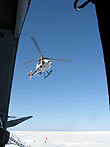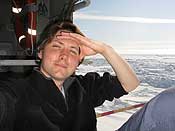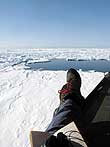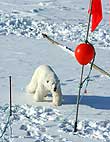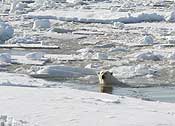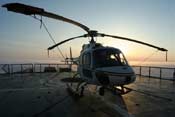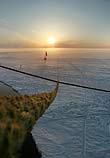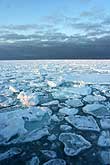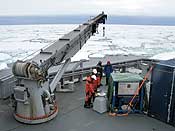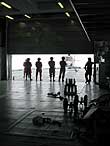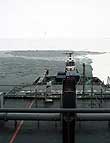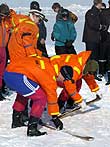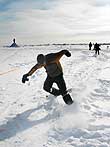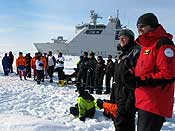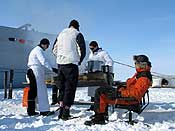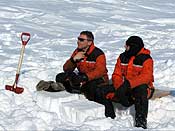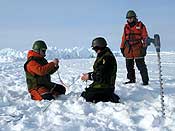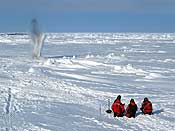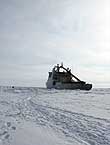End of leg 1
After a few days of quite hard work, yesterday provided a welcome opportunity to relax. The ship moored to an ice floe where it stayed for two days while the oceanographers continued to explore Eastwards by helicopter and the sea-ice people and the biologists studied the ice floe the ship was moored to and the things living underneath it. As there is only space for three people in the helicopter I reluctantly stayed behind on the ship (it was a stunning day for flying.).
Even worse, as one of our instruments only works with my laptop and not anyone else’s I had to let the helicopterists take my laptop with them. Without a computer I couldn’t do much more than label and organise sample bottles for leg 2, but that was actually not such a small task.
Anyway, I had the opportunity to soak just a few rays in a corner sheltered from the wind at lunchtime. It’s pretty rare to have more than a few minutes of free time even when spending two months on a research ship as there’s almost always something that needs to be done.
And, no sooner had I sat down on the deck than a message crackled over the radio by my side: “Bridge to ice … there’s polar bear about 300m away. Can you see it?” I recognise Steve’s voice on a distant walkie-talkie: “Errrm, no there’s lots of ridges. Perhaps we should come back to the ship?”, “Ummm… yes. Perhaps you should. out.”
We were under siege again (excellent!). In the photos you can see the bear approaching. As the beast was heading vaguely towards the gangplank the bridge tried to scare it with the ship’s horn (which is truly deafening) but the bear responded with an expression that looked more like anger than fear and sank its teeth a little deeper into one of the biologist’s mooring buoys! This float is nearly a meter in diameter and I was pretty amazed the bear could open it’s jaws wide enough to bite into the curved surface, but that didn’t appear to be a problem! After a while the bear wandered a little further away and then nonchalantly swam across the wake of open water that the ship left as it broke the ice on the way here! Apparently polar bears don’t think twice about a quick dip in -2 degree water.
The good weather lasted until late in the evening and yesterday ended in a spectacular sun-almost-set with a thin fog developing over the ice.
This morning the this fog was still hanging over the ice seemingly just a few meters deep, so I hurriedly donned my flying suit and packed a lunch box. Sadly two hours later the fog had still failed to burn off, and the conditions were changing from just-not-quite-good enough-weather to plain old bad weather, so after lunch I accepted I’d probably flown for the last time on this leg and hung my suit up in the hanger. Around dinner time though things began to improve and it looked like my flying sandwiches wouldn’t suffer the indignity of being eaten at the dinner table after all :). So got dressed again, jumped into the helicopter and made a bee-line for our last planned station. It was quite a nice flight over huge areas of dark nilus ice that’s almost clear enough to see through, but before we reached our station the windscreen (is that the right term?) began to frost over! so we rapidly descended to a low altitude and re-traced our bee-line back to the ship. We’d measured everything we wanted except for these last two stations. As the helicopter touched down we decided it was probably best to call an end to leg 1.
As I write this the ship is extracting itself from the ice flow we were moored to (no dynamite this time) and turning the sharp end to point at Longyearbyen. We should arrive in about two days, at which point I’ll be reunited with Hanneke, who is currently sitting in a plane heading to Tromsø.
